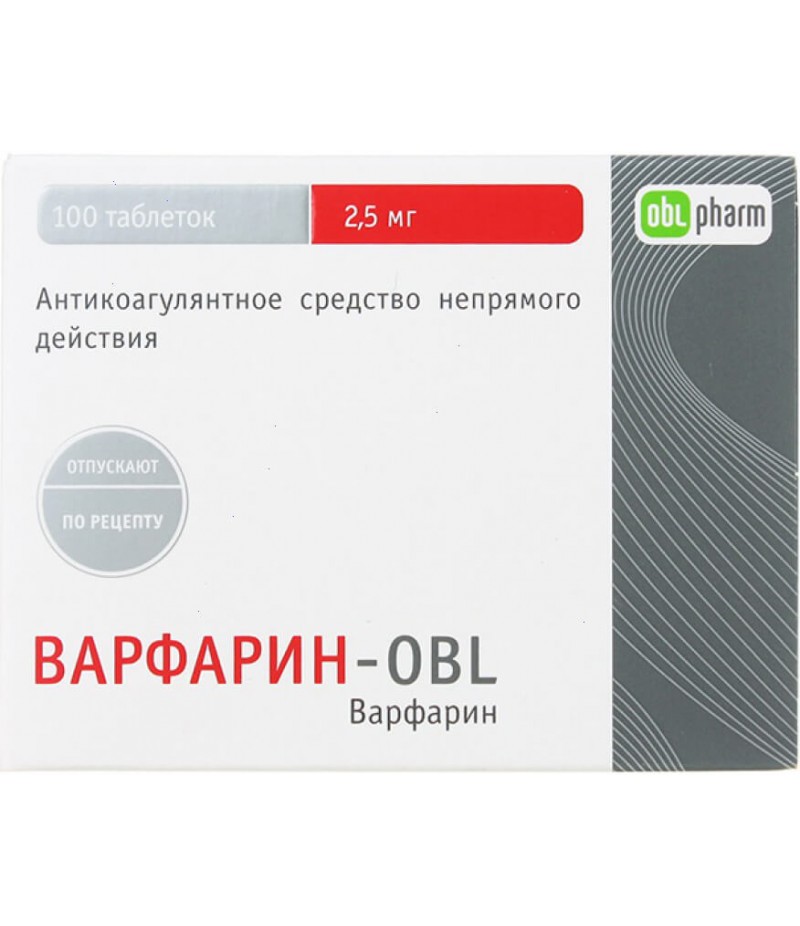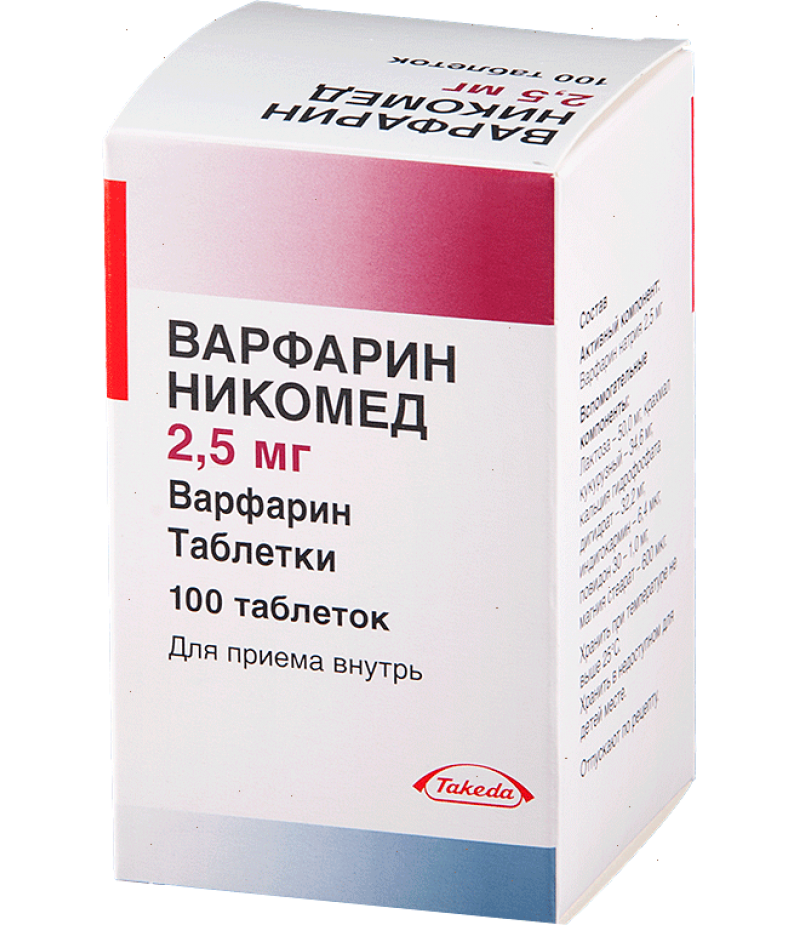Warfarin-OBL tabs 2.5mg #100
- $7.12
- 3 or more $6.99
- Availability:In Stock
Warfarin-OBL instructionYou can buy Warfarin-OBL hereIndications for useTreatment and prevention of thrombosis and vascular thromboembolism:- acute venous thrombosis and pulmonary thromboembolism;- postoperative thrombosis;- repea..
Tags: tabs
Warfarin-OBL instruction
You can buy Warfarin-OBL here
Indications for use
Treatment and prevention of thrombosis and vascular thromboembolism:
- acute venous thrombosis and pulmonary thromboembolism;
- postoperative thrombosis;
- repeated myocardial infarction;
- as an additional drug in the surgical or thrombolytic treatment of thrombosis, as well as in electrical cardioversion of atrial fibrillation;
- recurrent venous thrombosis;
- re-pulmonary thromboembolism;
- prosthetic heart valves and blood vessels (possible combination with acetylsalicylic acid (ASA);
- thrombosis of peripheral, coronary and cerebral arteries;
- secondary prevention of thrombosis and thromboembolism after myocardial infarction and atrial fibrillation.
Active ingredient, group:
Warfarin (Warfarin), an anticoagulant agent of indirect action
Dosage Form - pills
Contraindications for Warfarin-OBL
- hypersensitivity to warfarin and other components of the drug,
- acute bleeding,
- severe liver or kidney disease,
- severe arterial hypertension,
- acute DIC syndrome,
- deficiency of proteins C and S,
- hemorrhagic diathesis,
- thrombocytopenia,
- peptic ulcer of the stomach and duodenum in the acute stage,
- cerebral hemorrhage,
- alcoholism,
- renal failure,
- pregnancy
- hereditary lactose intolerance, lactase deficiency, glucose-galactose malabsorption.
Application during lactation is possible, but it is desirable to refrain from breastfeeding in the first three days of therapy with warfarin-OBL.
Dosage and administration (instructions)
Inside, 1 time per day at the same time.
The initial dose is 2.5-5 mg / day. Further dosing regimen set individually depending on the results of determining the prothrombin time or INR. The prothrombin time should be increased by 2-4 times from baseline, and the INR should reach 2.2-4.4, depending on the disease, the risk of thrombosis, the risk of bleeding and the individual characteristics of the patient. The duration of treatment depends on the condition of the patient. No gradual withdrawal of Warfarin-OBL is required.
When determining the INR, the sensitivity index of thromboplastin should be taken into account and this indicator should be used as a correction factor (1.22 when using domestic thromboplastin from the brain of the rabbit Neoplast and 1.2 when using thromboplastin produced by Rosh Diagnostics). Older and debilitated patients are usually prescribed lower doses of Warfarin-OBL.
Before the upcoming surgery (with a high risk of thromboembolic complications), treatment begins 2-3 days before surgery.
In the case of acute thrombosis, treatment is carried out in combination with heparin until the effect of oral anticoagulant therapy is fully manifested (no earlier than 3-5 days of treatment).
When prosthetic heart valves, acute venous thrombosis of the veins or thromboembolism (in the initial stages), left ventricular thrombosis and for the prevention of myocardial ischemia should strive for effective action, noted in INR 2.8-4.
In the case of atrial fibrillation and during maintenance therapy for venous thrombosis and thromboembolism, a moderate anticoagulant effect is achieved (INR 2,8-3).
When combined with Warfarin-OBL with acetylsalicylic acid, the INR value should be in the range of 2-2.5.
Data on the use of warfarin in children is limited. The initial dose is usually 0.2 mg / kg per day for normal liver function and 0.1 mg / kg per day for non-compliance. Maintenance dose is selected in accordance with the INR. Recommended INR levels are the same as in adults. The decision on the appointment of Warfarin-OBL in children should be made by an experienced specialist. Treatment should be carried out under the supervision of a pediatrician.
Pharmachologic effect
Warfarin OBL belongs to the group of indirect anticoagulants. Inhibits the synthesis of vitamin K-dependent coagulation factors (II, VII, IX and X) and proteins C and S in the liver. The optimal anticoagulant effect is observed 3-5 days after the start of the use of Warfarin-OBL and stops 3-5 days after taking the last dose.
Side effects of Warfarin-OBL
When using warfarin, the following adverse events were observed:
Most often:> 1/10 - bleeding.
Often:> 1/100, <1/10 - increased sensitivity to warfarin after prolonged use.
Infrequently:> 1/1 000, <1/100 - anemia, vomiting, abdominal pain, nausea, diarrhea.
Rarely:> 1/10 000, <1/1 000 - eosinophilia, increased activity of liver enzymes, jaundice, rash, urticaria, itching, eczema, skin necrosis, vasculitis, hair loss, nephritis, urolithiasis, tubular necrosis.
Bleeding. The most common risk factor for the occurrence of intracranial hemorrhage. The likelihood of bleeding increases if the INR (international normalized ratio) is significantly higher than the target level. If the bleeding started with an INR that is within the target level, then there are other related conditions that need to be investigated.
From the digestive system. Vomiting, nausea, diarrhea.
Necrosis. Coumarin necrosis. In 90% of cases, necrosis develops in women. Lesions are observed from the 3rd to the 10th day of Warfarin-OBL intake, etiology suggests a lack of antithrombotic protein C or S.
Palmar and plantar syndrome. A very rare complication of warfarin therapy, its development is typical for men with atherosclerotic diseases.
Other Hypersensitivity reactions, manifested in the form of skin rash and characterized by a reversible increase in the concentrations of liver enzymes, cholestatic hepatitis, vasculitis, priapism, reversible alopecia and tracheal calcification.
Independent risk factors for the development of serious bleeding when treating with warfarin are: advanced age, high intensity of concomitant anticoagulant and antiplatelet therapy, history of stroke and gastrointestinal bleeding. The risk of bleeding is increased in patients with CYP2C9 gene polymorphism.
The index of the effectiveness of treatment with warfarin-OBL is on the border of bleeding, so the patient may have minor bleeding, for example, microhematuria, gingival bleeding, etc. In mild cases, it is enough to reduce the dose of Warfarin-OBL or stop treatment for a short time until the INR reaches the target level. In the case of the development of severe bleeding, intravenous administration of vitamin K and oral administration of activated carbon, as well as the administration of a concentrate of coagulation factors or fresh frozen plasma, are indicated. If oral anticoagulants are indicated for further administration, large doses of vitamin K should be avoided, since resistance to warfarin develops within 2 weeks.
After treatment, long-term observation of the patient is necessary, given that the half-life of warfarin is 20-60 hours.
Special instructions
A prerequisite for treatment with warfarin-OBL is strict adherence to the patient receiving the prescribed dose of the drug.
Patients suffering from alcoholism, as well as patients with dementia, may be unable to comply with the prescribed regimen of warfarin.
Conditions such as fever, hyperthyroidism, decompensated heart failure, alcoholism with concomitant liver damage, may enhance the effect of warfarin.
In hypothyroidism, the effect of warfarin can be reduced.
In the case of renal failure or nephrotic syndrome, the level of the free fraction of warfarin in the blood plasma increases, which, depending on the associated diseases, can lead to both an increase and a decrease in the effect.
In the case of moderate liver failure, the effect of warfarin is enhanced.
In all the above states, a thorough monitoring of the INR level should be carried out.
Patients receiving warfarin are recommended to prescribe paracetamol, tramadol or opiates as painkillers.
If necessary, the onset of a rapid antithrombotic effect is recommended to begin treatment with the introduction of heparin; then, within 5-7 days, combination therapy with heparin and warfarin should be carried out until the target INR level is maintained for 2 days. In order to avoid coumarin necrosis, patients with hereditary deficiency of antithrombotic protein C or S must first be given heparin. Concomitant initial loading dose should not exceed 5 mg. Heparin administration should be continued for 5-7 days.
During the period of treatment with warfarin-OBL, it is necessary to refrain from the use of alcoholic beverages and drugs containing ethyl alcohol (the risk of hypoprothrombinemia and bleeding).
In the case of individual resistance to warfarin (rarely found), from 5 to 20 shock doses of warfarin are necessary to achieve a therapeutic effect. If reception of warfarin in these patients is ineffective, other possible causes should be identified, among which are possible: simultaneous use of warfarin with other drugs, inadequate diet, laboratory errors.
Treatment of elderly patients should be carried out with special precautions, because the synthesis of coagulation factors and hepatic metabolism in such patients is reduced, as a result of which an excessive effect from the action of warfarin may occur.
Interaction
Nonsteroidal anti-inflammatory drugs (NSAIDs), dipyridamole, valproic acid, inhibitors of cytochrome P450 (cimetidine, chloramphenicol) increase the risk of bleeding. The combined use of these drugs and warfarin should be avoided (cimetidine can be replaced with ranitidine or famotidine). If chloramphenicol treatment is needed, anticoagulant therapy should be temporarily discontinued.
Diuretics can reduce the effect of anticoagulants (in the case of pronounced hypovolemic action, which can lead to an increase in the concentration of coagulation factors).
Weaken the effect of warfarin: barbiturates, vitamin K, gluthethimide, griseofulvin, dicloxacillin, carbamazepine, mianserin, paracetamol, retinoids, rifampicin, sucralfate, phenazone, colestiramine.
Enhance the effect of warfarin: allopurinol, amiodarone, anabolic steroids (alkylated C17 position), ASA and other NSAIDs, heparin, glibenclamide, glucagon, danazol, diazoxide, disopyramide, disulfiram, isoniazid, ketoconazole, clarithromycin, clofibrate, levamisole, metronidazole, miconazole, nalidixic acid, nilutamide, omeprazole, paroxetine, proguanil, oral hypoglycemic drugs - sulfonamides derivatives, simvastatin, sulfonamides, tamoxifen, thyroxine, quinine, quinidine, fluvoxamine, fluconazole, fluorouracil, quinolones, chloral hydrate, chloramphenicol, cephalosporins, cimetidine, erythromycin, ethacrynic acid, ethanol. In the case of the combined use of warfarin with the above preparations, it is necessary to monitor the INR at the beginning and at the end of treatment and, if possible, 2-3 weeks after the start of therapy.
When using drugs (for example, laxatives), which can increase the risk of bleeding due to a decrease in normal coagulation (inhibition of blood clotting factors or liver enzymes), the strategy of anticoagulant therapy should be determined by the possibility of laboratory monitoring. If frequent laboratory control is possible, then, if therapy with similar drugs is necessary, the dose of warfarin can be reduced by 5-10%. If carrying out laboratory control is difficult, then if necessary, the appointment of these drugs warfarin should be canceled.
Terms of sell
You don't need a prescription to buy Warfarin-OBL.


